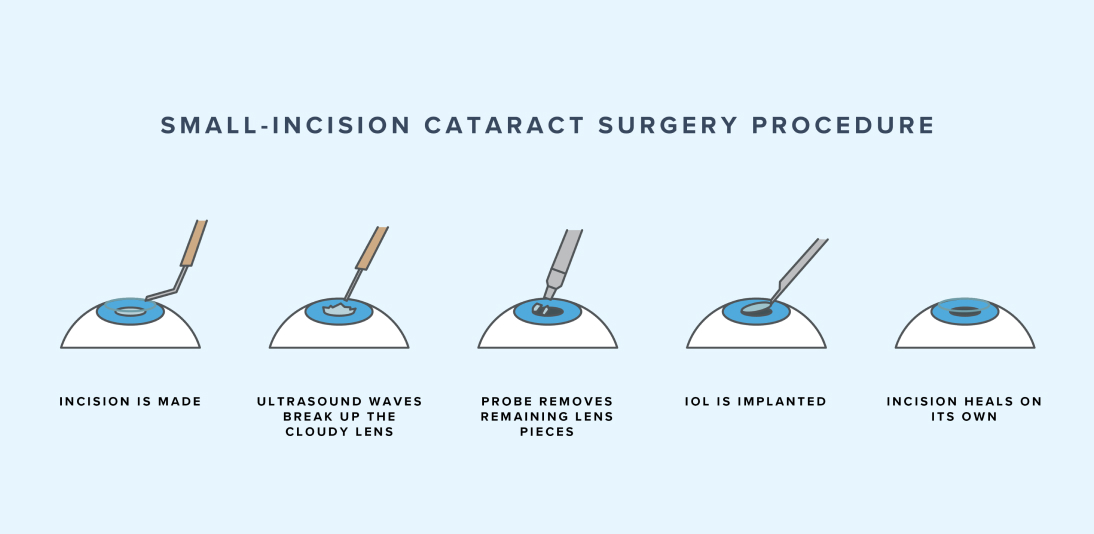A cataract is a clouding of the eye’s lens. It often causes blurred vision and can make glare from lights worse. Cataracts are common as people age, generally starting to develop around age 40, but people don’t usually notice them until around age 60 or older.
Cataract surgery, a type of eye surgery, is the main treatment for cataracts. Your eye doctor might suggest cataract surgery if your cataracts are causing vision problems that interfere with life’s daily activities, such as driving or walking safely, recognizing people’s faces, or reading.
In this article, we’ll discuss how to prepare for cataract surgery, what happens during the procedure, and what to expect after cataract surgery.
What Is Cataract Surgery?
Usually, cataract surgery is a procedure to restore eyesight lost because of cataracts. Sometimes, cataracts can get in the way of the doctor’s view of the retina at the back of the eye, and interfere with a comprehensive eye exam. In such cases, cataract surgery is necessary for doctors to fully examine the retina. This allows them to treat or diagnose eye disorders or eye diseases like age-related macular degeneration (AMD) or diabetic retinopathy.
Performed by an ophthalmologist, or eye surgeon, cataract surgery replaces the cloudy lens with a new artificial lens called an intraocular lens, or IOL. The new lens becomes part of your eye. You won’t be able to feel it, and it won’t need any special care.
Generally, cataract surgery is a painless, safe, and effective procedure, and it’s one of the most common surgeries in the United States. Most people age 80 or older have cataracts or have had cataract surgery.
Eye doctors typically do cataract surgery one eye at a time. If you have cataracts in both eyes, they might want you to wait at least a week or two between surgeries.
How Long Does Cataract Surgery Take?
Most of the time, cataract surgery is an outpatient procedure—you’ll go home the same day as the surgery.
In most cases, the procedure itself only takes between 10 and 20 minutes, but your doctor will need to prepare you for surgery, and you’ll need time to recover right after it. Altogether, you may be in the surgical center or doctor’s office for 2 or 3 hours total, but this will depend on your doctor’s practice.
Preparing for Cataract Surgery
Before your cataract procedure, you’ll have a comprehensive eye exam. Your eye doctor will usually check your eye health and measure your eye’s size and shape, often using ultrasound.
During the exam, you and your doctor will probably discuss benefits, risks, and other considerations for available IOL options. For instance, in addition to taking care of cataracts, the IOL could correct refractive errors such as myopia (nearsightedness), hyperopia (farsightedness), astigmatism, and presbyopia. IOL options for correcting refractive errors might include:
- Fixed-focus monofocal: Much like single vision glasses or contacts, a fixed-focus monofocal IOL has one focus strength to correct for distance vision. (So, reading may require reading glasses.)
- Accommodating-focus monofocal: Accommodating-focus monofocal IOLs also correct with one focus strength, but they can shift focus based on eye muscle movements for better vision at other distances.
- Multifocal: Like bifocal or progressive glasses or contacts, multifocal IOLs have multiple focus strengths at different areas of the lens. This lets them correct for viewing at near, middle, and far distances.
- Toric: Toric IOLs, like toric contacts, are specially shaped to correct astigmatism.
What to Do Before Cataract Surgery
Your doctor will give you instructions on what to do and what not to do in the days before the procedure. These instructions might include whether to stop eating, drinking, or taking medications a certain number of hours before the procedure.
If you wear contact lenses, your doctor will probably tell you how many days before the procedure you should stop wearing them. Your doctor might also prescribe antibiotic eye drops to use a day or two before the surgery.
You may need to arrange transportation for after the procedure, since you won’t be able to drive home.
Cataract Surgery Procedure
For the most part, you’ll be awake for the surgery, but your eye will be treated with topical anesthesia that numbs the eye so you don’t feel pain. Your doctor might also provide other medication to help you relax. During the cataract procedure, you won’t be able to see what the doctor is doing, though you might see light and motion.
How is cataract surgery done? The procedure always involves cataract removal and replacement with the IOL, but the methods doctors use might vary. Let’s take a look at three types of cataract surgery and go over what happens with each.
Small-Incision Cataract Surgery (Phacoemulsification)
This is the most common type of cataract surgery. The doctor puts a skinny probe through a tiny incision in the cornea at the front of the eye. The probe uses ultrasound waves to break up (emulsify) the cataract. Another probe then sucks out the remaining lens shards like a miniature vacuum cleaner. When the old lens has been completely removed, the doctor implants the IOL. Usually, the incision heals on its own with no stitches required.
Extracapsular Surgery (Manual Extraction)
This method requires a larger incision in the cornea. The doctor removes the entire natural lens at once with surgical tools and replaces it with the IOL. The doctor then stitches up the incision.
Laser-Assisted Cataract Surgery
The doctor places a special camera and ultrasound device over the eye. The device sends information about the eye to a computer, which then tells the laser how and where to make an incision. A probe uses ultrasound to break up the cataract, and another probe suctions out the remaining pieces. The doctor then inserts the IOL.
Generally, no stitches are needed to close the incision. The cost of this method tends to be higher than small-incision or extracapsular cataract surgery and is usually not covered by insurance.
Cataract Surgery Recovery
After the surgery, the doctor may put a special protective shield over your eyes while you rest. After around a half-hour, you’ll go home. You’ll typically see your eye doctor for follow-up care at one day, one week, and then one month after your cataract surgery.
Your eye doctor’s instructions for what to do at home might include:
- Using prescribed eye drops
- Wearing an eye patch, protective eye shield, or eyeglasses during the day
- Wearing a protective shield at night
- Wearing sunglasses in bright light
Your doctor may also want you to avoid some things as you recover from cataract surgery:
- Driving
- Places with lots of dust and debris that can get in the eye
- Rubbing or pressing on the eye
- Soap or water in or on the eye
- Strenuous exercise or heavy lifting
How Long Does It Take to Recover From Cataract Surgery?
It may take 1 to 2 months for your eyes to fully recover from cataract surgery and for you to see clearly. However, you may be able to do some work within a few days. After your eyes heal, you might need a new prescription for glasses or contact lenses.
Cataract Surgery Side Effects and Complications
Soon after your cataract surgery, you might notice that the world is more colorful since you’re no longer looking through a murky cloud, but you may have less pleasant side effects, too. These side effects, which usually subside within a few days, could include:
- Blurry vision
- Glare or halos
- Itchy or burning eyes
- Light sensitivity
- Red eyes
Rarely, complications such as retinal detachment, bleeding, infection, or lens dislocation can arise after cataract surgery. See an eye doctor right away if you experience any of these symptoms:
- Eye discharge
- Increased eye floaters
- Flashes of light
- Nausea, vomiting, or a lot of coughing
- Pain that doesn’t go away with over-the-counter pain relief
- Red eyes that get worse
- Swollen eyelids
- Vision loss
Secondary Cataracts
Sometimes, a complication called posterior capsular opacification, or secondary cataracts, can occur months or even years after cataract surgery. Secondary cataracts are cloudy patches on the lens capsule that surrounds the IOL. They can form as your eye heals from the cataract surgery.
To some, it might seem as if the cataract has returned because symptoms like blurred vision can mimic cataract symptoms—but cataracts can only form on the natural lens, not the IOL. The fix is a quick and simple procedure called posterior capsulotomy (or YAG laser capsulotomy), which removes the secondary cataracts with lasers.
People who have increased risk of developing secondary cataracts are those who had complications like eyelid swelling right after cataract surgery or people with these eye conditions:
- Diabetic retinopathy
- Glaucoma
- High myopia
- Retinitis pigmentosa
- Uveitis
Clear Vision Starts with Eye Care
Staying up-to-date with annual eye exams is the best way to safeguard your eye health and retain clear vision. If you suspect you have cataracts or are having any eye problems, make an eye appointment. Your doctor can test your vision and check for underlying conditions. Then, if you do have cataracts, you can discuss whether cataract surgery is a good option for you.







